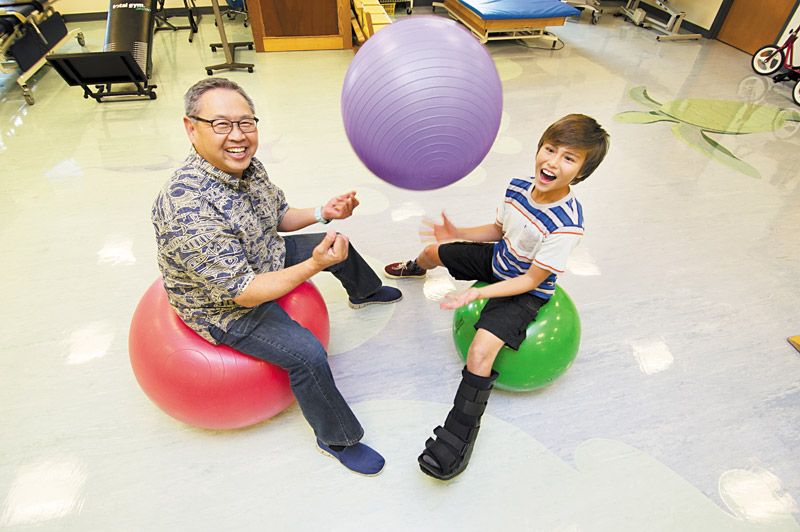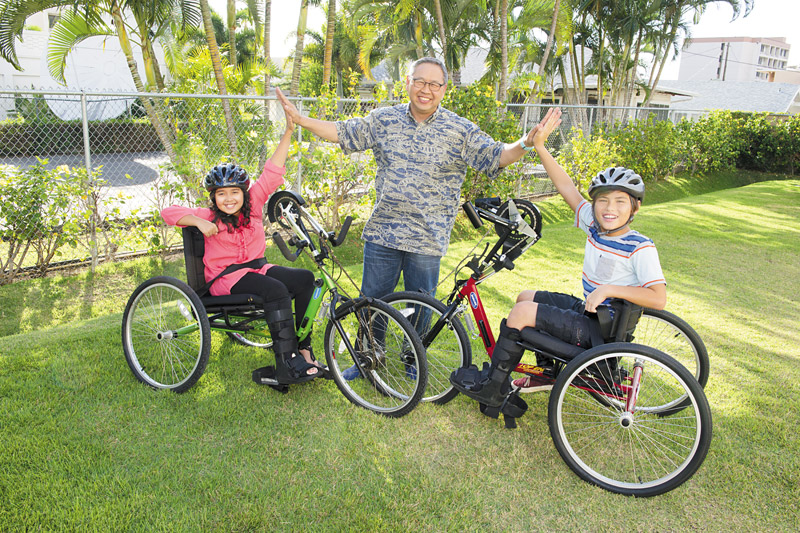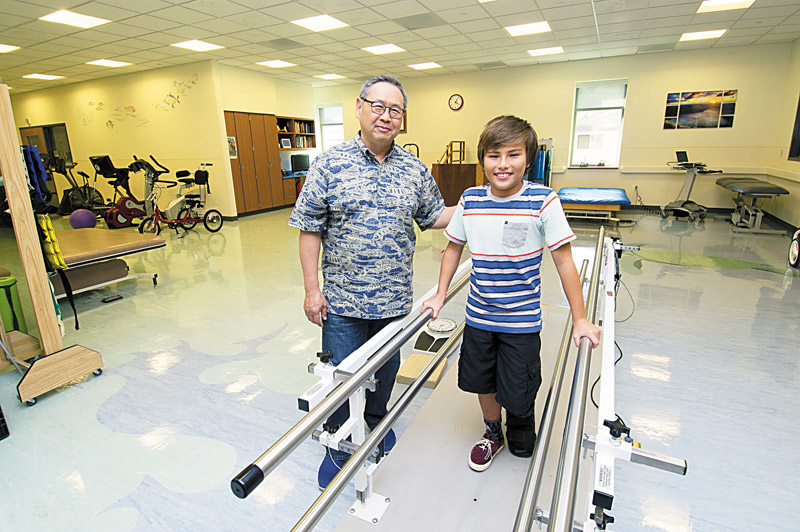That’s The Breaks

Injuries happen to young athletes, and when they do, Shriners has opened a one-stop clinic that offers diagnosis, treatment and rehab. Pictured are Dr. Craig Ono and skateboarder Jonathan Lau
Injuries happen to young athletes, and when they do, Shriners has a clinic that offers diagnosis, treatment and rehab. Pictured are Dr. Craig Ono, Emma Olivares and Jonathan Lau with hand cycles
Imagine this: Your car blows out a tire. You have to take it to one shop that tells you what you already know, your tire is flat. Then you have to tow it to the next shop, where they diagnose how it got flat and what will be needed to fix it. Finally it’s on to a third shop that will repair the tire and make sure it is safe to get back on the road.
You’d never stand for such inefficiency, yet that was exactly the situation for families with a child who has broken a bone: There was no one-stop shop for fractures and other sports-related injuries —until now.
Shriners Hospitals for Children-Honolulu is that place with its Injury Clinic, a dedicated service that focuses on injuries that happen on fields and courts, and sees them through from diagnosis to rehab.
“Now you just walk in and get taken care of,” says Dr Craig Ono, chief of staff at Shriners. “We do the evaluation — about 10 to 15 percent will need something done, a fracture reduced or put back in place, or they will need to have an operation to put the bone back in place, or having torn a ligament and they need something else. Most kids are just treated without surgery, but it is good to have that option to do surgery, if needed, and I don’t have to send them somewhere else.”
The clinic opened in 2013 as Fracture Clinic. Its name was changed to Injury Clinic in February and it deals with, on average, about 10 broken bones a week. It has four full-time orthopedic surgeons on staff to handle the initial work, plus a full rehab facility to get the kids back up and running.

No appointments are necessary — just walk in between 8 a.m. and noon Monday through Friday, and patients will receive total fracture care, which may include reduction, realignment, surgery, casting, post-fracture follow-up and rehabilitative care, if needed. If you come in after noon, they set you up for an appointment for the next morning.
Its mission is to accept all patients regardless of their lack of insurance or inability to pay for the services.
“We don’t turn anybody away. The only way we don’t treat someone is if we don’t feel we are the best place to treat a particular patient,” says Ono, who has been back with Shriners since 2001 after doing fellowship training there three decades ago.
“If we do send them out to another facility, their care is still under the umbrella of Shriners and if the family cannot pay for it, then we will take care of it.”
The history of Shriners goes back to 1870s Manhattan, where a group of Masons would meet for fraternal purposes at the Knickerbocker Cottage for lunch. It was a group that stressed the importance of fun and fellowship over the ritualistic bent of many other organizations of the day. It was the brainchild of physician Walter Fleming and actor Billy Florence, and though many of the emblems of the group — the crescent moon, the scimitar and the fez — have Islamic roots, the group was patently American.
After two generations of growth, it was decided that it should give back to the community, and the social club made a change for the greater good, founding its first Shriners Hospital for Cripple Children in Shreveport, Louisiana, in the fall of 1922, and its second hospital in Honolulu Jan. 2, 1923.
It is because of its original mission that Ono says Shriners still has to fight the perception in the community that it is just a hospital that treats kids from other countries or just for the chronically crippled.
“We are much more than that, and everyone who has come in and experienced what we have, they are kind of amazed because we do so much more,” says Ono, who recently was named 2015 Physician of the Year by the Healthcare Association of Hawaii.
“You come in with a fracture in your forearm, but you will have social workers to help you, we can make school accommodations like a wheelchair, therapists — things you won’t get at a doctor’s office. This is a system of care that focuses on the kid and their family and makes sure that everything else is taken care of, not just the injury.”
The Laus of Nuuanu bear witness to the importance of Shriners for all their children. When their youngest boy Daniel was born with a condition that caused the middle three fingers of his left hand to only grow into nubs, the staff at Shriners not only helped them understand why, but also how they could improve his quality of life.
So it was only natural when their eldest Jonathan finally landed his first 360-degree air on his skateboard at Hawaii Kai Skatepark and then promptly lost control of the board, injuring his leg, they looked to Shriners for his care.
“Even though both our dads recommended orthopedists to us that we could go to, we chose Shriners because we have had such a good experience here the past five years,” says Noelle Lau, whose father and father-in-law are both physicians.
“Everyone from the receptionist to the doctors to the X-ray technicians is so welcoming. As a mother, knowing we could possibly be dealing with rehab, I wanted to come to a place where I knew my kids would feel welcome and comfortable and safe, and that they could do everything for us so we wouldn’t have to be shuffling around from doctor to physical therapist.”
A hospital usually is never a place that children want to go, but with Shriners’ aquariums and toys that are donated to the sick, the elder Lau children actually were jealous of their youngest sibling’s treatment here.
Making the traumatic as enjoyable as possible for the kids is what it is all about for Ono.
“It is just a lot of fun, it is so much fun!” says Ono with a laugh, when speaking about his job. “Kids are a great group to take care of, especially when you talk about the orthopedic side. It is a very dynamic group because they are growing.
“It is a very challenging group, because they are growing. It is a worthwhile group to take care of because you get to see them grow up. We do a lot for the kids and we do a lot to the kids, but at the end of the day they will still give you a hug, and that is really rewarding. It is just so much fun.”
In addition to its treatment of local families, Shriners also does outreach throughout the Pacific with missions to Micronesia, Samoa, Fiji and Palau. While doctors do not perform operations in these remote locations, they do evaluate hundreds of children and bring back to Honolulu those in most need, and even house their families on the grounds while the youngsters are receiving treatment.
“The operations we do are very specialized, and those remote locations are not the best place to do these extensive operations, so we identify the kids who we think would benefit from coming to Honolulu for the care and bring them here, and then follow up with them once they return home,” says Ono, who rotates with his other physicians on these missions.
The doctors themselves are not Shriners, but Ono is forever grateful for all the fraternal order does for local families.
“It is a very good group. They are so dedicated — when you talk to these guys, they’re so focused on what the mission is and making sure that we have all the tools to be able to do it,” says Ono, who left the Army to take his position at the hospital.
“I thank them every time because they are the ones with this hospital that has given me the opportunity to do what I do. Without them, I wouldn’t be able to do this, and they were so essential with regard to my personal and professional development. It is just really awesome. They are the reason I am who I am.”
Allowing Ono and his staff to do their work is helping the children of Hawaii be a little less fearful of the dreaded hospital visit.






